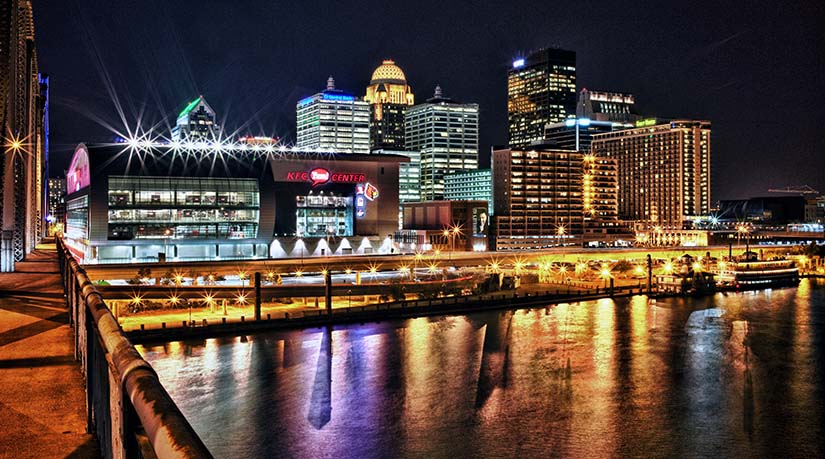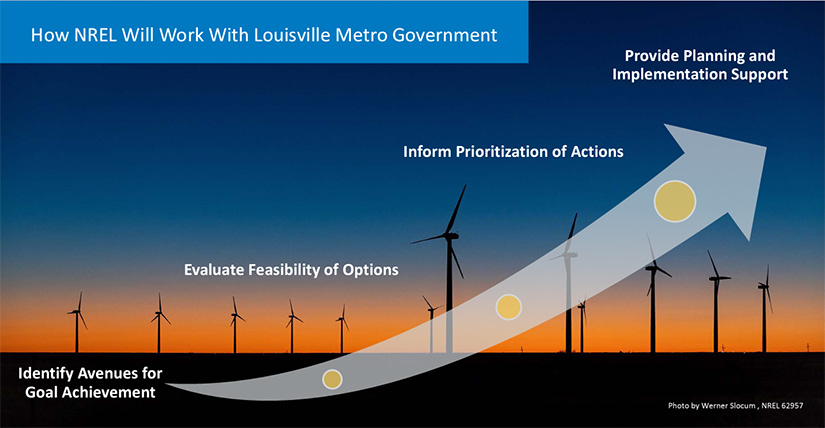Kentucky Community Partners With NREL To Meet 100% Clean Goals
The community of Louisville, Kentucky, is partnering with the National Renewable Energy Laboratory (NREL) to achieve a goal of 100% clean electricity for municipal government operations by 2030.
Earlier in 2021, the Louisville Metro Council passed an ordinance that set out the goals of 100% clean electricity for Louisville Metro Government (LMG) by 2030, for all LMG operations including transportation and building heating to decarbonize by 2035, and community-wide decarbonization by 2040.

“Louisville is excited to work with the NREL, a proven organization in achieving and reaching renewable goals,” Mayor Greg Fischer said in a LouisvilleKy.gov news story. “We must increase the percentage of our city’s energy sources that is run by renewables, and I believe, with the right partners at the table, we can do just that.”
The initial goal of the Louisville-NREL Partnership was to provide a road map of potential options for LMG to meet its 2030 goal, considering both the sources that LMG gets its electricity from and what cost-effective opportunities might exist to reduce electricity usage.
“We’ve been able to have some targeted impacts very quickly,” said Louisville-NREL Partnership Program Manager Owen Zinaman. “We’ve identified multiple options LMG has at its disposal to reach their 2030 goal, and in the next phase of our work, we’ll help identify which pathways should be prioritized over different timeframes.”
The project got underway after a citizen’s group, 100% Renewable Energy Alliance of Louisville (100% REAL), pushed LMG to start making the change.
“We have an incredibly strong advocacy group here in Louisville that has done so much work to build community support, but we were unsure of how to start,” said Allison Smith, assistant director of the Office of Advanced Planning and Sustainability for the LMG, who oversees all the climate change and sustainability efforts for the municipality. “It’s a really ambitious goal, and I don’t know if we could have ever gotten this far without NREL’s help. These are the people who can help us chart this course and figure out what our options are.”
NREL has advised both the LMG and 100% REAL on the facts of the situation.
“We get to be an honest broker of technical information and bring everyone up to speed on the facts, and it’s really refreshing.” Zinaman said. “The aim here is for the community to get a credible and objective assessment about how they can move forward, so they can have confidence in moving toward their goals.”
This is especially tricky for a community like Louisville because of the limited options they currently have available. LMG currently purchases electricity and receives public lighting service from Louisville Gas and Electric (LG&E). The provider is a regulated monopoly utility that generates 80%–90% of its energy from coal and 9%–19% from natural gas.*
Smith said the evolution to clean energy is necessary for Louisville and Kentucky.
“We’ve had two essentially climate emergencies very recently,” Smith said, pointing to the recent flooding and deadly tornadoes in Kentucky. “We are facing climate challenges every day, so the LMG felt the need to start advancing this in whatever way we could. It’s an achievable goal—it’s possible.”
NREL is dedicated to finding viable pathways available for the LMG to meet its 2030 goal, including the important role of energy efficiency.
“If you can cut your electricity demand by 25%, then that’s 25% less energy you have to buy to meet this goal,” Zinaman said.
NREL is also advising LMG on setting up a Clean Energy Innovation Fund, which will collect money saved on utility bills due to energy efficiency in municipal buildings and then reinvest the savings in further energy efficiency measures. NREL is providing LMG with guidance and analytical tools to decide which measures are most cost-effective and should be pursued first to most quickly reduce LMG’s reliance on fossil fuels.
The project is separated into two phases, with Phase One focusing on identifying avenues the partnership can use to achieve the goal and Phase Two evaluating feasibility before assisting with planning and implementation.

“I feel very excited about where this partnership is going, and I’ve already seen the impact we’ve had with such a small footprint,” Zinaman said. “It’s one of the most meaningful projects I’ve ever worked on, and I feel so lucky to be able to bring NREL resources to bear to support informed decision-making and help this incredible community achieve its goals.”
In Phase Two, NREL and LMG will investigate the possibility of LG&E’s voluntary Green Tariff program, prioritize energy efficiencies in LMG’s building fleet, and pinpoint “quick wins” for the project.
“At the end of Phase Two, we will have enough data and information to make an informed choice about how we proceed,” Smith said. “But we already know that due to our currently available options, energy efficiency and conservation is going to be a much bigger part than originally anticipated.”
Smith said the goal is not just to get a complete report from NREL but to keep using the partnership with an eye on results. “This job can feel like you’re pushing a boulder up hill, but I take satisfaction that every day we’re working to fight climate change and help move our city toward a more sustainable, resilient future. I anticipate a relationship with NREL through our 2040 goal at least,” she said.
“This is a long-term partnership,” Zinaman agreed. “We’re excited to be supporting Louisville for years to help them reach their goals. Understanding the goals and needs of the community members that LMG serves is an important part of the process. We are here to support a robust community-engagement process.”
NREL has already partnered with several state and local communities for similar programs, including Los Angeles Department of Water and Power for the Los Angeles 100% Renewable Energy Study (LA100). Other partnerships include New York State Energy Research and Development Authority; Dallas, Texas; Kingston, New York; Orlando, Florida; and Kansas City, Missouri.
Learn more about partnering with NREL.
Last Updated May 28, 2025
